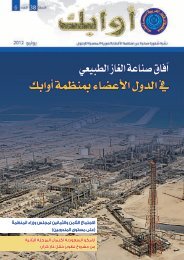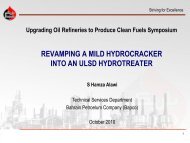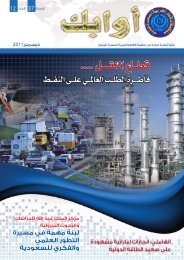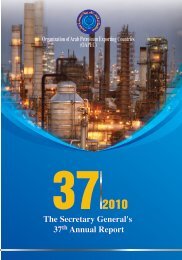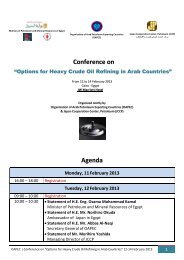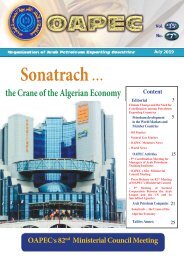chapter two - OAPEC
chapter two - OAPEC
chapter two - OAPEC
You also want an ePaper? Increase the reach of your titles
YUMPU automatically turns print PDFs into web optimized ePapers that Google loves.
Demand in the Asian developing countries rose by 400,000 b/d to 17.7<br />
million b/d in 2009. Chinese demand, which is the main engine of Asian<br />
economic growth and recovery, accounted for 46.3% of total demand in the<br />
Asian developing countries, and responsible for 50% of the increase in<br />
demand of the Asian developing countries and for 33% of the increase<br />
among all developing countries. Chinese demand rose by 200,000 b/d to<br />
8.2 million b/d in 2009. Chinese levels of domestic consumption and<br />
industrial output began to rise early in 2009. Besides, the use of China's<br />
economic stimulus program to upgrade its infrastructure has led to<br />
increasing demand for some heavy petroleum products, such as asphalt, in<br />
addition to the high demand for other products, such as gasoline, gas oil and<br />
naphtha which used as feedstock in petrochemical industry.<br />
India's economy, the other engine for Asian economies’ growth, saw a<br />
rise in demand for oil by 100,000 b / d to 3.2 million b / d in 2009. This was<br />
mainly due to the dependency of the Indian economy primarily on service<br />
and technological industries. While demand in the Latin American<br />
remained unchanged from its previous level of 5.8 million b/d, as shown in<br />
Table (1-7).<br />
2-3 Countries in Transition<br />
Oil demand in the countries in transition totalled 4.8 million b/d in<br />
2009, which was 100,000 b/d, or 2.0%, lower than the previous year.<br />
Demand in the FSU, which reached 3.2 million b/d in 2009, accounted for<br />
the whole decrease. Demand in the countries of Eastern Europe remained<br />
unchanged from previous level at 0.8 million b/d in 2009, as shown in<br />
Table (1-8).<br />
3. Price Trends<br />
3-1 Crude Oil Prices<br />
Despite the upward trend of oil prices in the course of 2009, their<br />
annual average rate declined for the first time since 2001. Price of OPEC<br />
basket of crudes fell by $33.4/b, or 35.4%, as the spot price averaged $61/b,<br />
compared with $94.4 in 2008.<br />
There was a wide disparity in the quarterly average prices in 2009. In<br />
the first quarter the average was about $42.9/b, representing a drop of<br />
$9.6/b or 18.3%, compared with the fourth quarter of previous year, rising<br />
in the second quarter by $15.6/b, or 36.4%, compared with the first quarter<br />
to $58.5/b. Then it rose by about $9.2/b, or 15.7% in the third quarter, to<br />
$67.7/b. However, in the last quarter it went up to $74.3/b, representing an<br />
increase of $6.6/b or 9.7%, compared with the third quarter.



